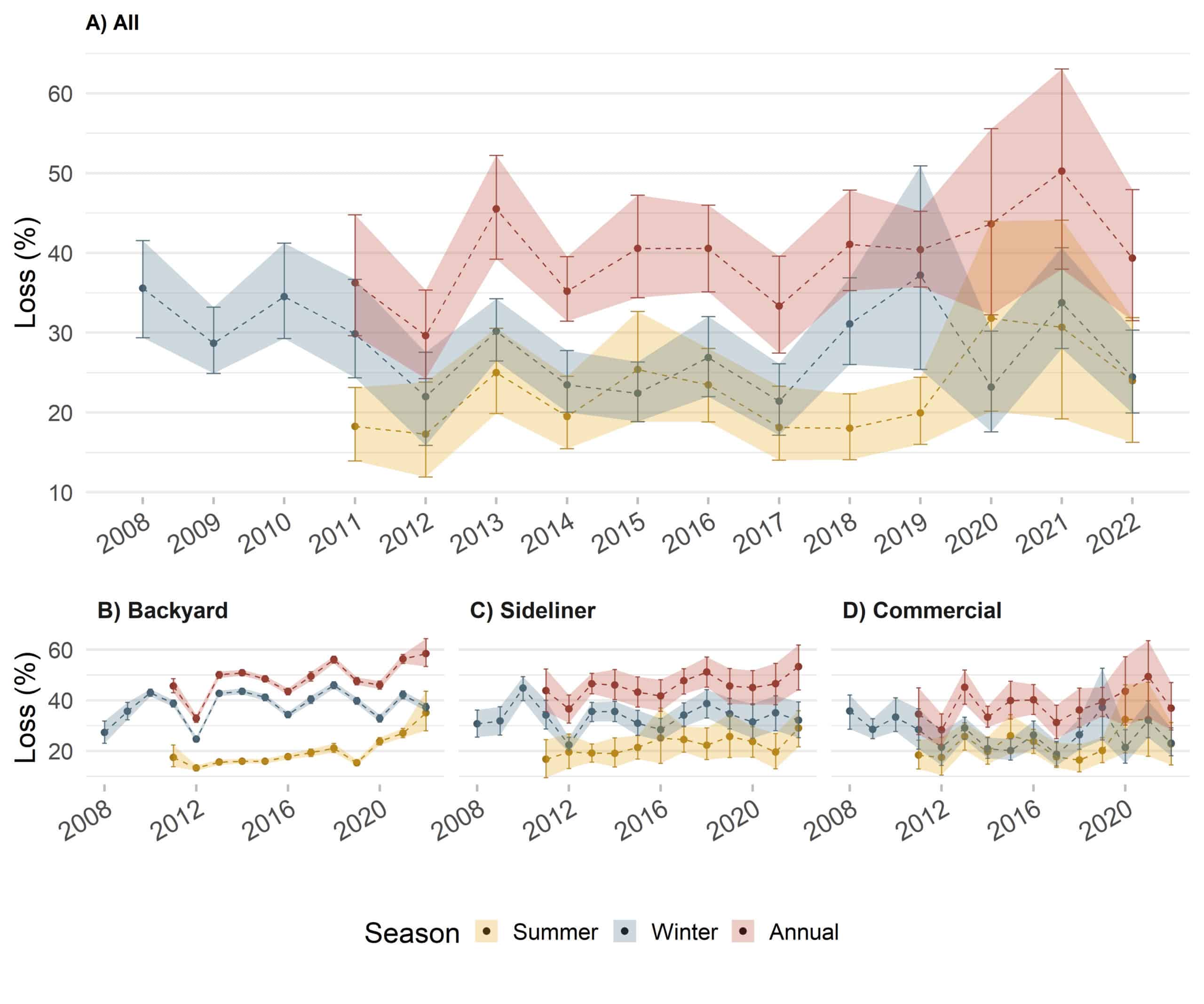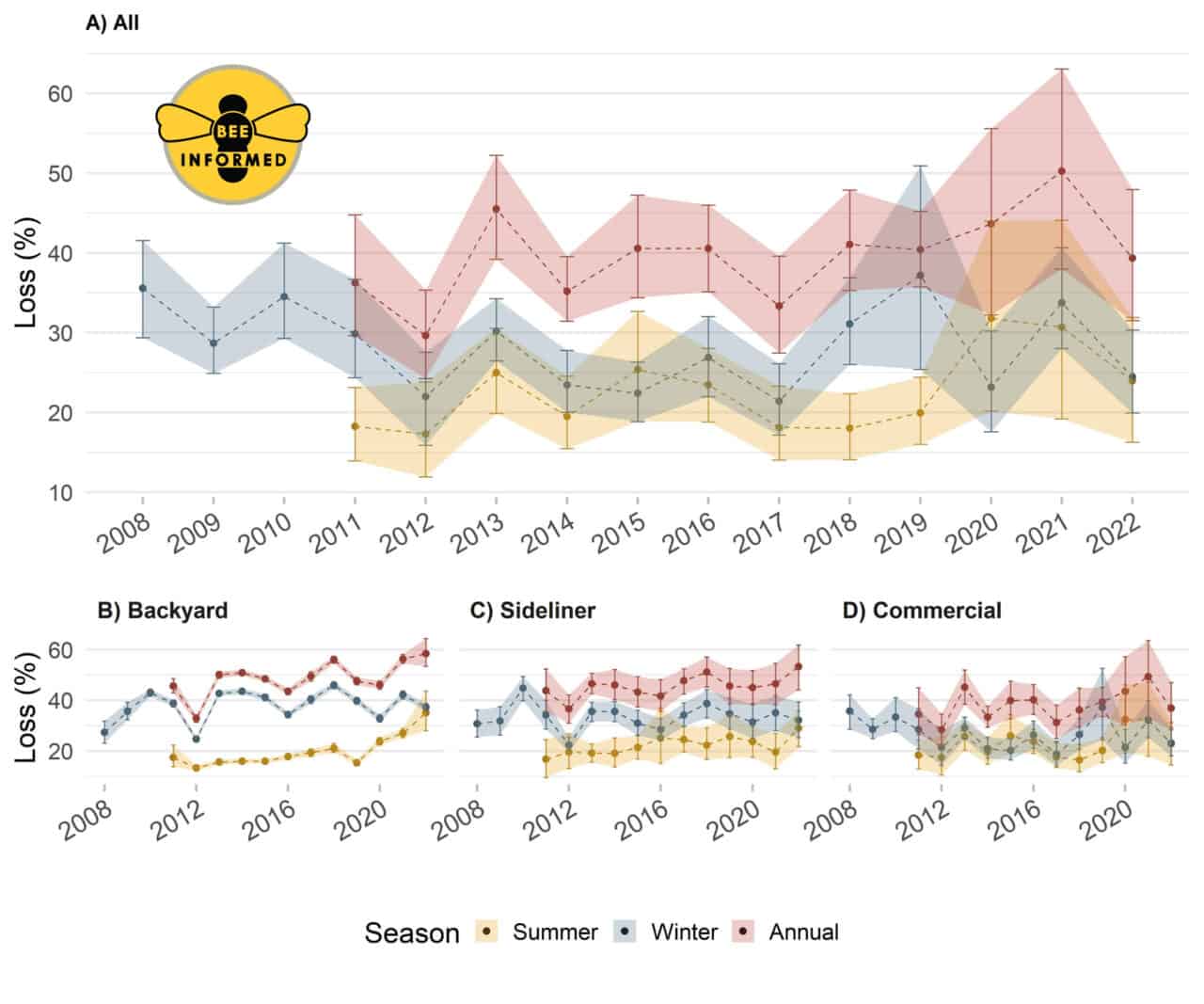Note: This is a preliminary analysis. Sample sizes and estimates are likely to change. A more detailed final report is being prepared for publication in a peer-reviewed journal at a later date.
Dan Aurell1, Selina Bruckner1, Mikayla Wilson2, 3, Nathalie Steinhauer2, 3, *, Geoffrey Williams1, *
1Department of Entomology & Plant Pathology, Auburn University, Auburn, AL, USA
2Department of Entomology, University of Maryland, College Park, MD, USA
3Bee Informed Partnership, College Park, MD, USA
*Joint last authors
Corresponding Authors: nsteinha@umd.edu (NS) & williams@auburn.edu (GW)
The Bee Informed Partnership (https://beeinformed.org) is a non-profit organization that works alongside beekeepers to improve honey bee colony health and survivorship across the United States. One of the organization’s longest running programs, the national Colony Loss and Management Survey, was initiated with the support of the Apiary Inspectors of America in 2007. Since then it has monitored managed honey bee colony loss rates and identified risk factors and protective measures associated with beekeeping management (Steinhauer, vanEngelsdorp and Saegerman, 2021).
This year marks the 16th anniversary of the survey, which relies on voluntary participation of beekeepers across the country during the month of April. It covered the one year period between April 2021 and April 2022.
This year, 3,601 beekeepers that collectively managed 335,946 colonies on 1 October 2021 in the United States provided validated survey responses. This represented 12% of the estimated 2.70 million managed honey-producing colonies in the country in 2021 (USDA NASS, 2022).
Colony loss rates were calculated as the ratio of the number of colonies lost to the number of colonies managed over a defined period. Loss rates should not be interpreted as a change in population size because beekeepers can replace lost colonies throughout the year. Therefore, colony loss rates are best interpreted as a turn-over rate, as high levels of losses do not necessarily result in a decrease in the total number of colonies managed in the United States.
During Summer 2021 (1 April 2021 – 1 October 2021), an estimated 23.8% [16.3 – 31.9, 95% bootstrapped confidence interval] of managed colonies were lost in the United States (Fig. 1). This was lower – 7.3 pp − than last year’s estimated summer colony loss (31.1% [19.2 – 44.1 CI]), but it was 1.3 pp higher than the average summer loss reported by beekeepers since the summer of 2010 (22.5%, 11 year average), when summer losses were first monitored.
During Winter 2021-2022 (1 October 2021 – 1 April 2022), an estimated 24.2% [20.0 – 30.3 CI] of managed colonies in the United States were lost (Fig. 1). This represented an improvement of 9.3 percentage points (pp) over the previous winter loss rate (33.5% [28.0 – 40.7 CI]), and was 4.3 pp lower than the average winter loss (28.5%, 14 year average) reported by beekeepers since the start of the survey in 2008.
Over the entire year (1 April 2021 – 1 April 2022), beekeepers in the United States lost an estimated 39.0% [31.5 – 47.9 CI] of their managed honey bee colonies (Fig. 1). This was 11.8 pp lower than last year’s estimated annual loss (50.8% [30.8 – 63.1 CI]), which was the highest annual loss on record, and 0.7 pp lower than the average loss rate (39.7%, 11 year average) over the last 11 years.

The honey bee industry in the United States is loosely divided into three groups of beekeepers − backyard (managing fewer than 50 colonies), sideliner (managing 51-500), and commercial (managing 501 or more colonies). As reported in previous years, backyard beekeepers experienced a higher annual rate of loss than commercial beekeepers in 2021-2022 (58.5% [53.4 – 64.4 CI] for backyard vs 36.6% [28.3 – 47 CI] for commercial). This represented the highest annual rate of loss on record for backyard beekeepers (10.6 pp more than their 11 year average of 47.9%), but it amounted to a typical year for commercial beekeepers (1.7 pp less than their 11 year average of 38.3%). Both backyard and sideliner beekeepers experienced winter rates of loss that were on par with previous years; however, commercial beekeepers experienced a lower winter rate of loss (22.8% [18.2 – 29.1]) compared to their historic average (14 year average of 27.2%).
Although the total number of honey bee colonies in the country has remained relatively stable over the last 20 years (~2.6 million colonies according to the USDA NASS Honey Reports), loss rates remain high, indicating that beekeepers are under substantial pressure to offset losses by creating new colonies every year. The Bee Informed Partnership’s annual Colony Loss and Management Survey offers an important record of such loss rates experienced by beekeepers across the United States each year. Before the start of the survey in 2007, no rigorous record was kept of the loss rates of colonies, making comparisons to historic levels difficult. In the last 16 years of the survey, our results have highlighted large variability in colony loss rates, not only among beekeeping operation types and locations, but also from year to year.
To obtain more information about the Bee Informed Partnership’s annual national Colony Loss and Management Survey, visit: https://beeinformed.org/citizen-science/loss-and-management-survey/.
References cited
Steinhauer, N., vanEngelsdorp, D. and Saegerman, C. (2021) ‘Prioritizing changes in management practices associated with reduced winter honey bee colony losses for US beekeepers’, Science of The Total Environment, 753, p. 141629. doi: https://doi.org/10.1016/j.scitotenv.2020.141629
USDA NASS (2022) Honey (March 2022). ISSN: 1949-1492. Available at: https://downloads.usda.library.cornell.edu/usda-esmis/files/hd76s004z/7m01cp956/df65wc389/hony0322.pdf (Accessed: 14 July 2022).
Previous survey results
Steinhauer, N., Aurell, D., Bruckner, S., Wilson, M., Rennich, K., vanEngelsdorp, D., Williams, G., for the Bee Informed Partnership (2021). United States Honey Bee Colony Losses 2020-2021: Preliminary Results. https://beeinformed.org/wp-content/uploads/2021/06/BIP_2020_21_Losses_Abstract_2021.06.14_FINAL_R1.pdf (Accessed 14 July 2022).
Bruckner, S., Steinhauer, N., Engelsma, J., Fauvel, A.M., Kulhanek, K., Malcom, E., Meredith, A., Milbrath, M., Nino, E.L., Rangel, J., Rennich, K., Reynolds, D., Sagili, R., Tsuruda, J., vanEngelsdorp, D., Aurell, S.D., Wilson, M.E., Williams, G.R., for the Bee Informed Partnership (2020). 2019-2020 Honey Bee Colony Losses in the United States: Preliminary Results. https://beeinformed.org/wp-content/uploads/2020/06/BIP_2019_2020_Losses_Abstract.pdf (Accessed 14 July 2022)
Bruckner, S., Steinhauer, N., Aurell, S.D., Caron, D.M., Ellis, J.D., Fauvel, A.M., Kulhanek, K., McArt, S., Mullen, E., Rangel, J., Sagili, R., Tsuruda, J., Wilkes, J.T., Wilson, M.E., Wyns, D., Rennich, K., vanEngelsdorp, D., Williams, G.R., for the Bee Informed Partnership (2019). 2018-2019 Honey Bee Colony Losses in the United States: Preliminary Results. https://beeinformed.org/wp-content/uploads/2019/11/2018_2019-Abstract.pdf (Accessed 14 July 2022)
Bruckner, S., Steinhauer, N., Rennich, K., Aurell, S.D., Caron, D.M., Ellis, J.D., Fauvel, A.M., Kulhanek, K., Nelson, K.C., Rangel, J., Rose, R., Sagili, R., Slater, G.P., Snyder, R., Thoms, C.A., Wilkes, J.T., Wilson, M.E., vanEngelsdorp, D., Williams, G.R., for the Bee Informed Partnership (2018) United States Honey Bee Colony Losses 2017-2018: Preliminary Results. https://beeinformed.org/wp-content/uploads/2019/11/2017-2018-Abstract.pdf (Accessed 21 July 2022).
Steinhauer, N., Rennich, K., Caron, D.M., Ellis, J.D., Koenig, P., Kulhanek, K., Klepps, J., Lee, K., Milbrath, M., Rangel, J., Rose, R., Sagili, R., Sallmann, B., Skinner, J., Snyder, R., Topitzhofer, E., Wilkes, J.T., Wilson, M.E., Williams, G.R., Wyns, D., vanEngelsdorp, D., for the Bee Informed Partnership. (2017) Honey Bee Colony Losses 2016-2017: Preliminary Results. https://beeinformed.org/wp-content/uploads/2019/11/2016-2017-Abstract.pdf (Accessed 21 July 2022).
Kulhanek, K., Steinhauer, N., Rennich, K., Caron, D. M., Sagili, R. R., Pettis, J. S., Ellis, J. D., Wilson, M. E., Wilkes, J. T., Tarpy, D. R., Rose, R., Lee, K., Rangel, J. and vanEngelsdorp, D. (2017) ‘A national survey of managed honey bee 2015–2016 annual colony losses in the USA’, Journal of Apicultural Research, 56(4), pp. 328–340. https://www.tandfonline.com/doi/full/10.1080/00218839.2017.1344496.
Lee, K. V., Steinhauer, N., Rennich, K., Wilson, M. E., Tarpy, D. R., Caron, D. M., Rose, R., Delaplane, K. S., Baylis, K., Lengerich, E. J., Pettis, J., Skinner, J. A., Wilkes, J. T., Sagili, R., vanEngelsdorp, D. and Partnership, for the B. I. (2015) ‘A national survey of managed honey bee 2013–2014 annual colony losses in the USA’, Apidologie, pp. 1–14. https://link.springer.com/article/10.1007/s13592-015-0356-z.
Seitz, N., Traynor, K. S., Steinhauer, N., Rennich, K., Wilson, M. E., Ellis, J. D., Rose, R., Tarpy, D. R., Sagili, R. R., Caron, D. M., Delaplane, K. S., Rangel, J., Lee, K., Baylis, K., Wilkes, J. T., Skinner, J. A., Pettis, J. S. and vanEngelsdorp, D. (2015) ‘A national survey of managed honey bee 2014–2015 annual colony losses in the USA’, Journal of Apicultural Research, 54(4), pp. 292–304. https://www.tandfonline.com/doi/full/10.1080/00218839.2016.1153294.
Spleen, A. M., Lengerich, E. J., Rennich, K., Caron, D., Rose, R., Pettis, J. S., Henson, M., Wilkes, J. T., Wilson, M., Stitzinger, J., Lee, K., Andree, M., Snyder, R., vanEngelsdorp, D., and for the Bee Informed Partnership (2013) ‘A national survey of managed honey bee 2011–12 winter colony losses in the United States: results from the Bee Informed Partnership’, Journal of Apicultural Research, 52(2), pp. 44–53. https://www.tandfonline.com/doi/abs/10.3896/IBRA.1.52.2.07.
Steinhauer, N. A., Rennich, K., Wilson, M. E., Caron, D. M., Lengerich, E. J., Pettis, J. S., Rose, R., Skinner, J. A., Tarpy, D. R., Wilkes, J. T. and vanEngelsdorp, D. (2014) ‘A national survey of managed honey bee 2012-2013 annual colony losses in the USA: results from the Bee Informed Partnership’, Journal of Apicultural Research, 53(1), pp. 1–18. https://www.tandfonline.com/doi/abs/10.3896/IBRA.1.53.1.01.
vanEngelsdorp, D., Caron, D., Hayes, J., Underwood, R., Henson, M., Rennich, K., Spleen, A., Andree, M., Snyder, R., Lee, K., Roccasecca, K., Wilson, M., Wilkes, J., Lengerich, E. and Pettis, J. (2012) ‘A national survey of managed honey bee 2010-11 winter colony losses in the USA: results from the Bee Informed Partnership’, Journal of Apicultural Research, 51(1), pp. 115–124. https://www.tandfonline.com/doi/abs/10.3896/IBRA.1.51.1.14.
vanEngelsdorp, D., Hayes, J., Underwood, R. M., Caron, D. and Pettis, J. (2011) ‘A survey of managed honey bee colony losses in the USA, fall 2009 to winter 2010’, Journal of Apicultural Research, 50(1), pp. 1–10. https://www.tandfonline.com/doi/abs/10.3896/IBRA.1.50.1.01.
vanEngelsdorp, D., Hayes, J., Underwood, R. M. and Pettis, J. (2008) ‘A Survey of Honey Bee Colony Losses in the U.S., Fall 2007 to Spring 2008’, PLoS ONE, 3(12). https://journals.plos.org/plosone/article?id=10.1371/journal.pone.0004071.
vanEngelsdorp, D., Hayes, J., Underwood, R. M. and Pettis, J. S. (2010) ‘A survey of honey bee colony losses in the United States, fall 2008 to spring 2009’, Journal of Apicultural Research, 49(1), pp. 7–14. https://www.tandfonline.com/doi/abs/10.3896/IBRA.1.49.1.03.
vanEngelsdorp, D., Underwood, R., Caron, D. and Hayes, J. (2007) ‘An estimate of managed colony losses in the winter of 2006-2007: A report commissioned by the apiary inspectors of America’, American Bee Journal, 147(7), pp. 599–603.
